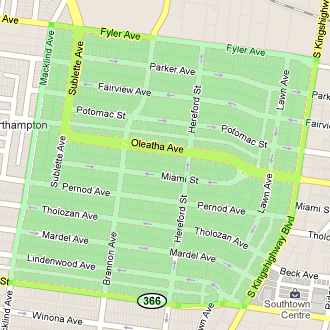North – South Streets Sources: (1) The Streets of St. Louis: A History of St. Louis Street Names, by William B .and Marcella C.  Mahan. Virginia Publishing Company, St .Louis, MO 63108 © 1994, 1996. (Secondrevised edition)   (2)  St. Louis Public Library searchable online list compiled by Dr. Glen Holt and Thomas A.Pearson.
 KINGSHIGHWAY:  Kingshighway originated as an Indian trail to a portage on the Missouri River. White settlers called it the King’s Trace (or highway), as they called most roads running between the king’s land and the common fields. (Le Rue de Roi for the French; El Camino Real for the Spanish).  It was the western boundary of the Prairie des Noyers Common Field. It became the main stem of the Kingshighway Boulevard “system†adopted by the city in 1903. ( Source: Streets of St. Louis*)
At one time, there were many Kingshighways in St. Louis: Union Blvd. was “Second Kingshighway;†Bircher Blvd. was “Kingshighway Northeast†or “Kingshighway-Bircher;â€Â Kingshighway Southwest†comprised Christy, Holly Hills and Bellerive boulevards, with the Christy stretch sometimes referred to as “Kingshighway-Christy.â€Â And “Grand Kingshighway†ran from Carondelet Park north to Bellerive Boulevard. Today’s Kingshighway Boulevard run through eight neighborhoods: Cabanne, Central West End, Clifton, Grand Prairie, The Hill, Oak Hill, Shaw and Southwest.
NORTH KINGSIGHWAY BLVD. was renamed KINGSHIGHWAY MEMORIAL BLVD. in 1922 to honor military heroes killed in World War I.  Kingshighway Memorial ran from Easton Ave. (now Martin Luther King, Jr. Dr.) to West Florissant Ave. The ordinance has never been repealed, so Kingshighway Memorial still exists, running through the Arlington, Fairground and Walnut Park neighborhoods.
LAWN AVENUE Appeared between Oakland and Berthold avenues in the 1912 Forest Lawn Subdivision, it received its name from the subdivision. Neighborhoods: Oakland and Southwest. (St. Louis Public Library)
HEREFORD and SUBLETTE honor Mrs. Frances Hereford Sublette, wife of the fur and Indian trader, Solomon Sublette. Part of the Fairmount Heights Subdivision of 1868 was developed on Sublette family lands. Neighborhoods: The Hill, Oakland and Southwest. (St. Louis Public Library) Frances’ first husband was William Sublette, who was appointed in 1845 by Thomas Hart Benton to be Superintendent of Indian Affairs in Washington, DC. On his way, he died; Frances eventually married his brother Solomon. (Streets of St. Louis)
BRANNON AVENUE was originally platted in the 1871 subdivision of St. Louis Heights and named for John B. Brannon, a city deputy sheriff in the 1850s. Neighborhoods: The Hill and Southwest. (Library)
SUBLETTE AVENUE appeared on St. Louis maps dating back to the 1850s. It was named in honor of William L. and Solomon B. Sublette, western fur traders who were landowners in Gratiot League Square. Portions of Sublette Ave. were also known as Cheltenham Avenue and Blue Ridge Road until 1881. It was Blue Ridge Road from Connecticut to Pernod until 1881. Neighborhoods: The Hill, Oakland and Southwest. (Library)
MACKLIND AVENUE began as St. Louis Avenue in the Fairmont Heights Subdivision of 1868. It was renamed in 1881 to honor of Thomas H. Macklind, district engineer of the city street department. Neighborhoods: The Hill, Oakland and Southwest. (Library)Â Â Â Â Â Â Â Â Â Â Â Â Â Â Â Â Â Â Â Â Â Â Â Â Â Â Â Â Â Â Â ###Â Â Â Â Â Â Â Â Â Â Â Â Â Â Â ###Â Â Â Â Â Â Â Â ###




